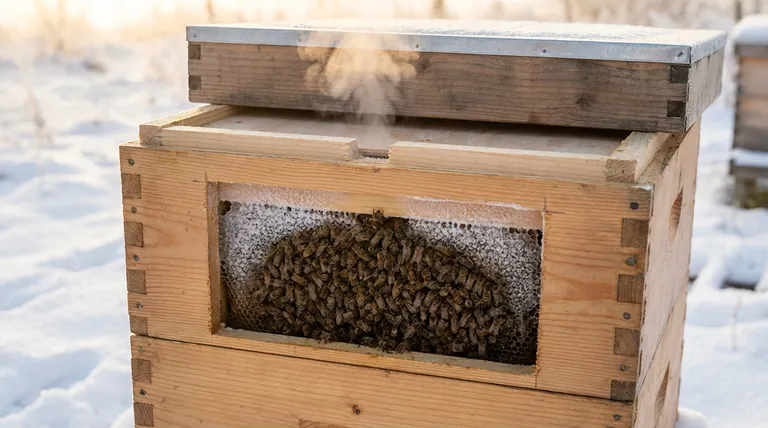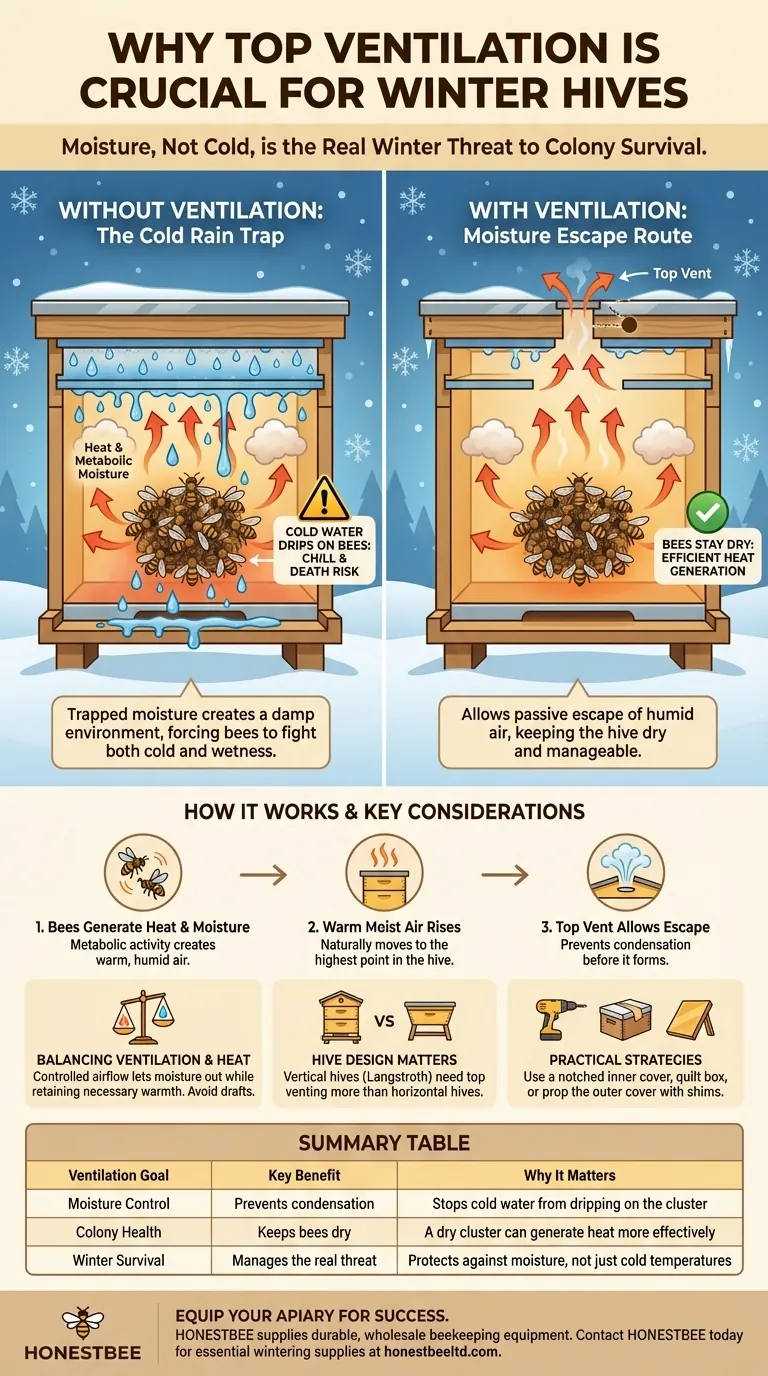The primary reason for top ventilation in a beehive during winter is to allow the colony's metabolic moisture to escape. Without a path out, this warm, humid air condenses on the cold inner surfaces of the hive, creating a "rain" of cold water that can chill and kill the bee cluster below.
The greatest danger to a honeybee colony in winter isn't the cold itself, but being cold and wet. Proper top ventilation is a critical strategy to ensure the humid air generated by the bees can exit before it condenses and fatally drips back down on them.

The Real Winter Threat: Moisture, Not Cold
To manage your hive effectively, you must understand the true enemy. Healthy bees are masters of generating heat, but they are highly vulnerable to moisture.
How Bees Generate Heat and Moisture
Honeybees do not heat the entire hive cavity in winter. Instead, they form a tight cluster and generate warmth by vibrating their wing muscles, a process fueled by consuming honey.
A significant byproduct of this metabolic activity is water vapor. Think of the cluster as a single, breathing organism exhaling warm, moist air into the cold hive.
The Physics of Condensation in a Hive
This warm, humid air naturally rises. When it makes contact with the cold inner cover or telescoping top, it cools rapidly.
Just as your breath fogs a cold window, the water vapor in the hive's air condenses into liquid water. This accumulation of water is what poses a direct threat to the colony.
How Top Ventilation Solves the Moisture Problem
A small opening at the top of the hive fundamentally changes the internal environment, transforming it from a damp trap into a dry, safe shelter.
Creating an Escape Route for Wet Air
A top entrance or vent provides a simple exit point for the rising warm, moist air. This allows for passive air exchange, letting damp air out before it has a chance to cool and condense.
Preventing the "Cold Rain" Effect
By preventing condensation from forming in the first place, you eliminate the risk of cold water dripping onto the bees. Keeping the cluster dry is paramount, as it allows them to dedicate their energy to heat generation rather than fighting off a chilling dampness.
Understanding the Trade-offs
Many beekeepers worry that ventilation will let too much heat escape. This concern is valid but must be placed in the proper context.
The Myth of a "Drafty" Hive
The goal of winter ventilation is not to create a draft. We are aiming for a small, controlled exit for air, not a wind tunnel. A 1-inch hole or a slightly propped inner cover is sufficient.
Balancing Ventilation with Heat Retention
You are intentionally letting some heat escape, but this is a necessary compromise. That escaping heat carries the damaging moisture with it. A dry and slightly cooler hive is far safer and more survivable for the bees than a warm but wet one.
Why Hive Design Matters
This moisture problem is most pronounced in vertical hives like the common Langstroth. Heat and moisture rise directly into the "attic" space, making a top vent essential.
In contrast, horizontal hives like a top bar hive are less susceptible. The cluster moves laterally, so the warmest, most humid air doesn't get trapped directly above them in the same way. This design gives bees an inherent advantage in managing moisture.
Practical Ventilation Strategies for Your Hive
Choosing the right ventilation method depends on your equipment and local climate. The underlying principle, however, remains the same: give moisture an escape path.
- If you are using a standard Langstroth hive: Provide a small upper exit, such as a 1-inch drilled hole in the top box, a notched inner cover, or shims placed between the top box and inner cover.
- If you are concerned about excess heat loss: Use a quilt box, which is a shallow box filled with wood shavings placed above the cluster. It insulates while absorbing moisture and allowing it to vent out slowly.
- If your primary goal is simplicity: The easiest method is to simply prop the front of the outer cover forward with a small stick or shim, creating a small gap for air to escape.
Ultimately, keeping your bees dry is the single most important factor in helping them survive the winter.
Summary Table:
| Ventilation Goal | Key Benefit | Why It Matters |
|---|---|---|
| Moisture Control | Prevents condensation | Stops cold water from dripping on the cluster |
| Colony Health | Keeps bees dry | A dry cluster can generate heat more effectively |
| Winter Survival | Manages the real threat | Protects against moisture, not just cold temperatures |
Ensure your apiary is equipped for winter success. Proper hive management starts with the right equipment. HONESTBEE supplies durable, well-designed beekeeping supplies and equipment to commercial apiaries and beekeeping equipment distributors through our wholesale-focused operations. Let us help you protect your investment and ensure your colonies thrive through the colder months.
Contact HONESTBEE today for wholesale pricing on essential wintering supplies.
Visual Guide

Related Products
- Black Plastic Beetle Barn Hive Beetle Trap for Beehives
- Professional Drop-Style Hive Handles for Beekeeping
- Professional Hive Front Entrance Bee Feeder
- Professional Bamboo Queen Isolation Cage
- Reusable Clear Small Hive Beetle Traps for Beehives Beetle Trapping Tools
People Also Ask
- What is the recommended number of beetle traps per hive? Optimize Your Hive's Beetle Defense
- What tips can help prevent hive beetle infestations? Build Strong Colonies & Master Apiary Hygiene
- How should beetle traps be placed in the hive? Achieve Perfect Flush Placement for Maximum Control
- What are the chemical-free options for trapping hive beetles? Control Pests Without Chemicals
- How do hive beetle traps work? A Beekeeper's Guide to Non-Chemical Control



















